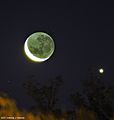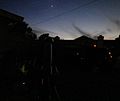Conjunction (astronomy and astrology) facts for kids
A conjunction is an amazing event you can see in the sky! It happens when two or more space objects, like planets, the Moon, or stars, appear very close to each other from our view here on Earth. Even though they look close, they are actually still millions of miles apart in space. It's like when two cars on a highway look close together from far away, but they are still on different lanes.
The special symbol for a conjunction is ☌ (which looks a bit like a cross with a circle on top). You might see this symbol in old astronomy books or charts. ![]()
Contents
What is a Conjunction?
A conjunction is all about how things look from our planet. Imagine you are watching a race from the side. Two runners might look like they are right next to each other, even if one is a bit ahead or behind. In space, planets orbit the Sun at different speeds and distances. Sometimes, their paths line up just right so that from Earth, they seem to meet in the sky.
This doesn't mean they crash or get closer in space. It just means they are in the same direction from our point of view. Think of it like a trick of perspective!
Why Do Conjunctions Happen?
Conjunctions happen because all the planets in our Solar System orbit the Sun in a flat, disc-like area called the ecliptic. The Moon also orbits Earth near this same plane. Because they all move along this general path, they often cross paths in our line of sight.
Planets move at different speeds. Inner planets like Venus and Mercury move faster than outer planets like Mars or Jupiter. This difference in speed means they constantly change their positions relative to each other. Every now and then, they "catch up" or "pass" each other from our perspective.
Types of Conjunctions
There are a few ways we describe conjunctions:
- Planetary Conjunctions: This is when two or more planets appear close together. For example, Jupiter and Saturn often have beautiful conjunctions.
- Lunar Conjunctions: This happens when the Moon appears close to a planet or a bright star. The Moon moves quickly across the sky, so lunar conjunctions are quite common.
- Solar Conjunctions: This is when a planet passes behind the Sun from Earth's view. We can't see these because the Sun's bright light blocks them.
How to See a Conjunction
Conjunctions are usually easy to spot! You don't need a telescope for most of them. Just look up at the sky, especially around dawn or dusk. The planets often look like very bright stars.
To find out when the next conjunction is happening, you can check astronomy websites or apps. They will tell you which planets to look for and where in the sky to find them. Sometimes, a conjunction can be so close that the two objects look like one super-bright "star"!
Famous Conjunctions
Throughout history, people have been fascinated by conjunctions. They were often seen as important signs.
- The Great Conjunction: One of the most famous is the conjunction of Jupiter and Saturn. These two giant planets meet in the sky about every 20 years. The one in December 2020 was especially close, making them look almost like a single bright object!
- Moon and Venus: The Moon and Venus often have stunning conjunctions. Venus is the brightest planet, and when it's near the crescent Moon, it creates a beautiful sight in the evening or morning sky.
Conjunctions are a great way to connect with the night sky and see the amazing dance of our Solar System!
Images for kids
-
A conjunction of Mars and Jupiter in the morning of 1 May 2011, when, about an hour before sunrise, five of the Solar System's eight planets and the Moon could be seen from Cerro Paranal, Chile.
-
Talitha Borealis in conjunction with the comet C/2020 F3 (NEOWISE) on 18 July 2020 21:30 UTC with an attitude von 17° above the north horizon of Berlin (image height = 4°). At the lower edge of the picture, a bit left from the centre there is the neighbour star Alkaphrah (Kappa Ursae Majoris respectively Talitha Australis). The distance between Talitha Borealis and C/2020 F3 was seven arc minutes.
See also
 In Spanish: Conjunción (astronomía) para niños
In Spanish: Conjunción (astronomía) para niños











